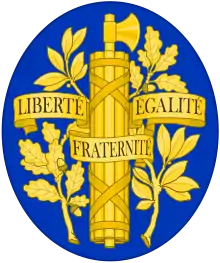Henry III of France
Henry III (French: Henri III, né Alexandre Édouard; Polish: Henryk Walezy; Lithuanian: Henrikas Valua; 19 September 1551 – 2 August 1589) was King of France from 1574 until his death as well as King of Poland and Grand Duke of Lithuania from 1573 to 1575.
| Henry III | |
|---|---|
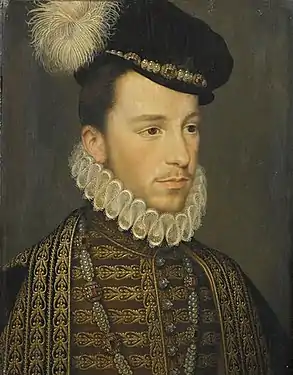 Portrait by Jean de Court | |
| King of France (more...) | |
| Reign | 30 May 1574 – 2 August 1589 |
| Coronation | 13 February 1575, Reims |
| Predecessor | Charles IX |
| Successor | Henry IV |
| King of Poland Grand Duke of Lithuania | |
| Reign | 16 May 1573 – 12 May 1575 |
| Coronation | 22 February 1574, Wawel |
| Predecessor | Sigismund II Augustus |
| Successor | Anna and Stephen |
| Interrex | Jakub Uchański |
| Born | 19 September 1551 Château de Fontainebleau, France |
| Died | 2 August 1589 (aged 37) Château de Saint-Cloud, France |
| Burial | 23 June 1610 Basilica of St Denis, France |
| Spouse | Louise of Lorraine |
| House | Valois-Angoulême |
| Father | Henry II of France |
| Mother | Catherine de' Medici |
| Religion | Roman Catholicism |
| Signature |  |
As the fourth son of King Henry II of France, he was not expected to inherit the French throne and thus was a good candidate for the vacant throne of the Polish–Lithuanian Commonwealth, where he was elected monarch in 1573. During his brief rule, he signed the Henrician Articles into law, recognizing the Polish nobility's right to freely elect their monarch. Aged 22, Henry abandoned Poland upon inheriting the French throne when his brother, Charles IX, died without issue.
France was at the time plagued by the Wars of Religion, and Henry's authority was undermined by violent political factions funded by foreign powers: the Catholic League (supported by Spain and the Pope), the Protestant Huguenots (supported by England and the Dutch) and the Malcontents (led by Henry's own brother the Duke of Alençon, a party of Catholic and Protestant aristocrats who jointly opposed the absolutist ambitions of the king). Henry III was himself a politique, arguing that a strong and religiously tolerant monarchy would save France from collapse.
After the death of Henry's younger brother Francis, Duke of Anjou, and when it became apparent that Henry would not produce an heir, the Wars of Religion developed into a succession crisis, the War of the Three Henrys. Henry III's legitimate heir was his distant cousin, King Henry III of Navarre, a Protestant. The Catholic League, led by Henry I, Duke of Guise, sought to exclude Protestants from the succession and championed the Catholic Charles, Cardinal of Bourbon, as Henry III's heir.
In 1589, Jacques Clément, a Catholic fanatic, murdered Henry III. He was succeeded by the King of Navarre who, as Henry IV, assumed the throne of France after converting to Catholicism, as the first French king of the House of Bourbon.
Early life
Childhood
Henry was born at the royal Château de Fontainebleau, the fourth son of King Henry II and Catherine de' Medici. He was a grandson of Francis I of France and Claude of France. His older brothers were Francis II of France, Charles IX of France, and Louis of Valois. He was made Duke of Angoulême and Duke of Orléans in 1560, then Duke of Anjou in 1566.
He was his mother's favourite; she called him chers yeux ("precious eyes") and lavished fondness and affection upon him for most of his life.[1] His elder brother, Charles, grew to detest him, partially because he resented his better health.
The royal children were raised under the supervision of Diane de Poitiers.[2]
Youth
In his youth, Henry was considered the best of the sons of Catherine de' Medici and Henry II.[3] Unlike his father and elder brothers, he had little interest in the traditional Valois pastimes of hunting and physical exercise. Although he was both fond of fencing and skilled in it, he preferred to indulge his tastes for the arts and reading. These predilections were attributed to his Italian mother.
At one point in his youth he showed a tendency towards Protestantism as a means of rebelling. At the age of nine, calling himself "a little Huguenot", he refused to attend Mass, sang Protestant psalms to his sister Margaret (exhorting her all the while to change her religion and cast her Book of Hours into the fire), and even bit the nose off a statue of Saint Paul. His mother firmly cautioned her children against such behaviour, and he would never again show any Protestant tendencies. Instead, he became nominally Roman Catholic.[4]
In the factional dispute that engulfed France in the wake of Henry II's death in 1559, Henry was solicited by Henry I, Duke of Guise at the behest of Jacques, Duke of Nemours to run away from court to be a figurehead for the ultra-Catholics.[5] It was however uncovered before any action could be taken.[5]
Sexuality
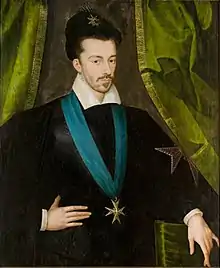
Reports that Henry engaged in same-sex relations with his court favourites, known as the mignons,[6][7] date back to his own time. Certainly he enjoyed intense relationships with them.[8] The scholar Louis Crompton maintains that all of the contemporary rumours were true.[9] Some modern historians dispute this. Jean-Francois Solnon,[10] Nicolas Le Roux,[11] and Jacqueline Boucher[12] have noted that Henry had many famous mistresses, that he was well known for his taste in beautiful women, and that no male sex partners have been identified. They have concluded that the idea he was homosexual was promoted by his political opponents (both Protestant and Catholic) who used his dislike of war and hunting to depict him as effeminate and undermine his reputation with the French people.[13] Certainly his religious enemies plumbed the depths of personal abuse in attributing vices to him, topping the mixture with accusations of what they regarded as the ultimate devilish vice, homosexuality. And the portrait of a self-indulgent sodomite, incapable of fathering an heir to the throne, proved useful in efforts by the Catholic League to secure the succession for Cardinal Charles de Bourbon after 1585.[8]
Gary Ferguson found their interpretations unconvincing: "It is difficult to reconcile the king whose use of favourites is so logically strategic with the man who goes to pieces when one of them dies."[14] Katherine Crawford, by contrast, emphasizes the problems Henry's reputation encountered because of his failure to produce an heir and the presence of his powerful mother at court, combined with his enemies' insistence on conflating patronage with favouritism and luxury with decadence.[15]
Elizabeth
In 1570, discussions commenced arranging for Henry to court Queen Elizabeth I of England. Elizabeth, almost 37, was expected by many parties in her country to marry and produce an heir. However, nothing came of these discussions. In initiating them, Elizabeth is viewed by historians as having intended only to arouse the concern of Spain, rather than contemplate marriage seriously. The chance of marriage was further blighted by differing religious views (Henry was Catholic, Elizabeth Protestant) and his opinion of Elizabeth. Henry tactlessly referred to Elizabeth as a putain publique (public whore) and made stinging remarks about their difference in age (he was 18 years younger). Upon hearing (inaccurately) that she limped because of a varicose vein, he called her an "old creature with a sore leg".[4]
Wars of Religion
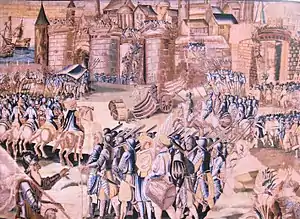
In November 1567, upon the death of Anne de Montmorency, Henry assumed the role of Lieutenant-General of France placing him in nominal control of France's military.[16][17] Henry would go on to serve as a leader of the royal army, taking part in the victories over the Huguenots at the Battle of Jarnac (March 1569)[18] and at the Battle of Moncontour (October 1569).[19] At this time he was a rallying point for the ultra-Catholics at court, who saw him as an opposition figure to the toleration line being taken by the King, with Charles, Cardinal of Lorraine guiding his council.[16] Lorraine offered him 200,000 Francs of Church revenue to become a protector of Catholicism, and tried to arrange his marriage to Mary, Queen of Scots however neither project took off.[20]
While still Duke of Anjou, he helped plot the St. Bartholomew's Day Massacre of 1572. Though Henry did not participate directly, historian Thierry Wanegffelen sees him as the royal most responsible for the massacre, which involved the targeted killing of many key Huguenot leaders. Henry III's reign as King of France, like those of his elder brothers Francis and Charles, would see France in constant turmoil over religion.
Henry continued to take an active role in the Wars of Religion, and in 1572/1573 led the siege of La Rochelle, a massive military assault on the Huguenot-held city.[21] At the end of May 1573, Henry learned that the Polish szlachta had elected him King of Poland (a country with a large Protestant minority at the time) and political considerations forced him to negotiate an end to the assault. Negotiators reached an agreement on 24 June 1573, and Catholic troops ended the siege on 6 July 1573.
King of Poland and Grand Duke of Lithuania (1573–1575)
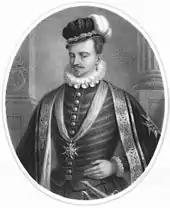
Following the death of the Polish ruler Sigismund II Augustus on 7 July 1572, Jean de Monluc was sent as the French envoy to Poland to negotiate the election of Henry to the Polish throne in exchange for military support against Russia, diplomatic assistance in dealing with the Ottoman Empire, and financial subsidies.[22]
On 16 May 1573, Polish nobles chose Henry as the first elected monarch of the Polish–Lithuanian Commonwealth. The Lithuanian nobles boycotted this election, however, and it was left to the Lithuanian ducal council to confirm his election.[23] The commonwealth elected Henry, rather than Habsburg candidates, partly in order to be more agreeable to the Ottoman Empire (a traditional ally of France through the Franco-Ottoman alliance) and strengthen a Polish-Ottoman alliance that was in effect.[24]
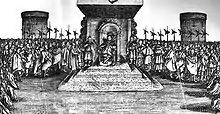
A Polish delegation went to La Rochelle to meet with Henry, who was leading the Siege of La Rochelle. Henry left the siege following their visit.[25] In Paris, on 10 September, the Polish delegation asked Henry to take an oath, at Notre Dame Cathedral, to "respect traditional Polish liberties and the law on religious freedom that had been passed during the interregnum".[26] As a condition of his election, he was compelled to sign the Pacta conventa and the Henrician Articles, pledging religious tolerance in the Polish–Lithuanian Commonwealth.[27] Henry chafed at the restrictions on monarchic power under the Polish-Lithuanian political system of "Golden Liberty".[27] The Polish-Lithuanian parliament had been urged by Anna Jagiellon, the sister of the recently deceased king Sigismund II Augustus, to elect him based on the understanding that Henry would wed Anna afterward.[28]
At a ceremony before the Parlement of Paris on 13 September, the Polish delegation handed over the "certificate of election to the throne of Poland-Lithuania".[26] Henry also gave up any claims to succession and he "recognized the principle of free election" under the Henrician Articles and the pacta conventa.[26]
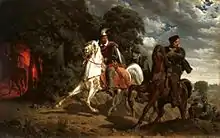
It was not until January 1574 that Henry was to reach the borders of Poland. On 21 February, Henry's coronation was held in Kraków.[29] In mid-June 1574, upon learning of the death of his brother Charles IX, Henry left Poland and headed back to France.[29] Henry's absence provoked a constitutional crisis that the Parliament attempted to resolve by notifying Henry that his throne would be lost if he did not return from France by 12 May 1575.[29] His failure to return caused Parliament to declare his throne vacant.[29]
The short reign of Henry at Wawel Castle in Poland was marked by a clash of cultures between the Polish and the French. The young king and his followers were astonished by several Polish practices and disappointed by the rural poverty and harsh climate of the country.[27] The Poles, on the other hand, wondered if all Frenchmen were as concerned with their appearance as their new king appeared to be.[27]
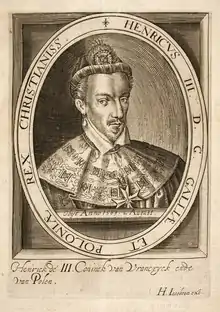
In many aspects, Polish culture had a positive influence on France. At Wawel, the French were introduced to new technologies of septic facilities, in which litter (excrement) was taken outside the castle walls.[30] On returning to France, Henry wanted to order the construction of such facilities at the Louvre and other palaces.[30] Other inventions introduced to the French by the Polish included a bath with regulated hot and cold water, as well as dining forks.
In 1578, Henry created the Order of the Holy Spirit to commemorate his becoming first King of Poland and later King of France on the Feast of Pentecost and gave it precedence over the earlier Order of St. Michael, which had lost much of its original prestige by being awarded too frequently and too readily. The Order would retain its prestige as the premier chivalric order of France until the end of the French monarchy.
French reign (1575–1589)
Henry was crowned king of France on 13 February 1575 at Reims Cathedral. Although he was expected to produce an heir after he married Louise of Lorraine,[31] age 21, on 14 February 1575, no issue resulted from their union.
In 1576, Henry signed the Edict of Beaulieu, which granted many concessions to the Huguenots. His action resulted in the Catholic activist Henry I, Duke of Guise, forming the Catholic League. After much posturing and negotiations, Henry was forced to rescind most of the concessions that had been made to the Protestants in the edict.
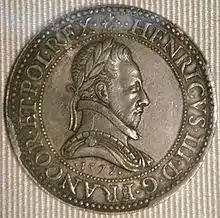
In 1584, the King's youngest brother and heir presumptive, Francis, Duke of Anjou, died. Under Salic Law, the next heir to the throne was Protestant Henry of Navarre, a descendant of Louis IX (Saint Louis). Under pressure from the Duke of Guise, Henry III issued an edict suppressing Protestantism and annulling Henry of Navarre's right to the throne.
On 12 May 1588, when the Duke of Guise entered Paris, an apparently spontaneous Day of the Barricades erupted in favor of the Catholic champion. Henry III fled the city.
Following the defeat of the Spanish Armada that summer, the king's fear of Spanish support for the Catholic League apparently waned. Accordingly, on 23 December 1588, at the Château de Blois, he invited the Duke of Guise to the council chamber where the duke's brother Louis II, Cardinal of Guise, already waited. The duke was told that the king wished to see him in the private room adjoining the royal bedroom. There, royal guardsmen murdered the duke, then the cardinal. To make certain that no contender for the French throne was free to act against him, the king had the duke's son imprisoned.
The Duke of Guise had been very popular in France, and the citizenry turned against Henry for the murders. The Parlement instituted criminal charges against the king, and he was compelled to join forces with his heir, the Protestant Henry of Navarre, by setting up the Parliament of Tours.
Overseas relations
Under Henry, France named the first Consul of France in Morocco in the person of Guillaume Bérard. The request came from the Moroccan prince Abd al-Malik, who had been saved by Bérard, a doctor by profession, during an epidemic in Constantinople and wished to retain Bérard in his service.[32]
Henry III encouraged the exploration and development of New World territories. In 1588, he granted Jacques Noël, the nephew of Jacques Cartier, privileges over fishing, fur trading, and mining in New France.[33]
Assassination and burial
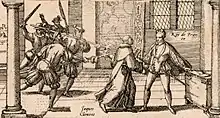
On 1 August 1589, Henry III lodged with his army at Saint-Cloud, and was preparing to attack Paris, when a young fanatical Dominican friar, Jacques Clément, carrying false papers, was granted access to deliver important documents to the king. The monk gave the king a bundle of papers and stated that he had a secret message to deliver. The king signalled for his attendants to step back for privacy, and Clément whispered in his ear while plunging a knife into his abdomen. Clément was then killed on the spot by the guards.
At first, the king's wound did not appear fatal, but he enjoined all the officers around him, in the event that he did not survive, to be loyal to Henry of Navarre as their new king. The following morning, on the day that he was to have launched his assault to retake Paris, Henry III died.
Chaos swept the attacking army, most of it quickly melting away; the proposed attack on Paris was postponed. Inside the city, joy at the news of Henry III's death was near delirium; some hailed the assassination as an act of God.[34]
Henry III was interred at the Saint Denis Basilica. Childless, he was the longest-living of Henry II's sons to have become king and also the last of the Valois kings. Henry III of Navarre succeeded him as Henry IV, the first of the kings of the House of Bourbon.
Arms
Ancestors
In popular culture
Poetry
- Jan Kochanowski, Gallo crocitanti (1576)
- Pierre Matthieu, La Guisiade (1589)
Theatre
- George Chapman, The Tragedy of Bussy D'Ambois (1607) and The Revenge of Bussy D'Ambois (1613)
- John Dryden and Nathaniel Lee, The Duke of Guise (1683)
- Alexandre Dumas, père's Henry III and His Court (1829)
- Christopher Marlowe, The Massacre at Paris (1593)
Novel
- Alexandre Dumas, père's novels: La Reine Margot (1845), La Dame de Monsoreau (1846) and Les quarante-cinq (1847).
- Alexandre Dumas Les deux Diane (1846)
- Stanley Weyman, A Gentleman of France (1893), involves the events of Henry's reconciliation with the Huguenots and struggle against the Catholic League, leading to his assassination.
- Last Days of Henry III, King of France at IMDb
- Robert Merle Paris ma bonne ville (1980)
- Robert Merle Le prince que voilà (1982)
- Robert Merle La violente amour (1983)
- Jean Plaidy Queen Jezebel (1953)
- Michel Zevaco Les Pardaillan (1900)
- S.J. Parris Conspiracy (2015)
Film
- The French short film The Assassination of the Duke de Guise (1908) shows the Duke's assassination but not the Cardinal's. The co-director, Charles Le Bargy, plays the Duke.
- The American silent film Intolerance (1916) depicts Henry as effeminate but not explicitly homosexual. He is portrayed by the British-born American actor Maxfield Stanley.
- The French movies La Reine Margot (1954) and La Reine Margot (1994), both based on Alexandre Dumas, père's novel of the same title, are fictional depictions of the lives of Henry III's family, his sister Margot, and her Protestant husband Henry around the time of the St. Bartholomew's Day Massacre. In the 1994 film, Henry is played by the actor Pascal Greggory. In Dumas' novel, Henri was not portrayed as homosexual, whereas, in the 1954 film, he was shown as an effeminate, comical queen. In the 1994 film, he was portrayed as a more sinister character, bisexual and showing sexual interest in his sister. His brother dies by being accidentally poisoned by his mother, who had intended to kill Henry of Navarre instead.
- As the Duke of Anjou, the future Henry III plays a significant role in the French film The Princess of Montpensier, based on the novel of the same title by Madame de La Fayette.
- The film Elizabeth, released in 1998, depicts a fictional courtship between Elizabeth I of England and Henry III while he was still Duke of Anjou. In reality, the two never met and the Queen of England was actually courted nearly ten years later by his younger brother François, Duke of Anjou, when Elizabeth was 46. The film borrows some of the aspects of Henry III's life and features Anjou as a comical foolish transvestite. The role is portrayed by the French actor Vincent Cassel.
- In the film Dangerous Beauty, he has an assignation with the main character, the Venetian courtesan Veronica Franco. Visiting a Venice eager for military aid, the "French king" chooses her from among the famous courtesans of that city because he notices her reluctance; placing a blade at her neck, he tells Veronica that the "rumours" about him are true (that "the king is a pervert"), and the implication is made that Veronica pleases him enormously by first correctly guessing at and then indulging his fetish for BDSM domination. (When the king emerges from Franco's house in the morning, the assembled Venetian nobility awaiting, he smiles broadly while carefully settling his presumably sore posterior on a pillow, and then declares that the French navy shall assist the Venetians against the Ottoman Empire in defense of their rule of Cyprus.) He is played by the British actor Jake Weber.
Television
- In an episode of Animaniacs entitled "The Three Muska-Warners", an Elmer Fudd–like Henri III is protected by Yakko, Wakko and Dot. In this version, Henri is portrayed by Jeff Bennett as nervous and jumpy, and for no apparent reason speaks with an English accent.
- He is also featured in a few episodes in the first and third seasons of the CW show Reign. In the show's fourth season, Henry is played by Nick Slater. With his brother showing little interest in the job, Spain wants Henry to become France's king.
Opera
- Chabrier's opéra-comique Le roi malgré lui (1887) deals with the unhappy Polish episode, with Henri as the reluctant King of Poland. In Kraków, he conspires with Polish nobles to depose himself. His friend Nangis changes places with him, but in the end, the plot fails and the curtain falls on Henri being crowned.
Notes
- Mariéjol 1920, p. 204.
- Wellman 2013, p. 209.
- Young, Jan (2010). The Assassins. ISBN 9780557952748.
- Frieda, Leonie, Catherine de Medici, pp.179–180
- Carroll, Stuart (2009). Martyrs and Murderers: The Guise Family and the Making of Europe. Oxford University Press. p. 186. ISBN 9780199596799.
- "Henri III était homosexuel" [Henry III was gay]. Tatoufaux.com. Archived from the original on 1 February 2009. Retrieved 18 December 2010.
- "Henri III". Archived from the original on 14 June 2008. Retrieved 2 March 2008.
- Diarmuid MacCulloch, Reformation: Europe's House Divided, Penguin, 2004
- Crompton, Louis (2003). "Henry III and the Mignons". Homosexuality and Civilization. Cambridge: Harvard University Press. pp. 328–330. ISBN 0-674-01197-X.
- Solnon, Jean-Francois (1987). La Cour de France. Paris: Fayard.
- Le Roux, Nicolas (2006). Un régicide au nom de Dieu, l'assassinat d'Henri III (in French). Paris: Gallimard. ISBN 2-07-073529-X.
- Boucher, Jacqueline (1986). La cour de Henri III (in French). Rennes: Ouest-France. ISBN 2-7373-0019-3.
- Honoré Gabriel Riqueti, comte de Mirabeau. Erotika Biblion. 1783. https://archive.org/stream/erotikabiblion00mirauoft#page/n5/mode/1up
- Ferguson, Gary (2008). Queer (Re)Readings in the French Renaissance: Homosexuality, Gender, Culture. Aldershot/Burlington: Ashgate. ISBN 978-0-7546-6377-5.
- Katherine B. Crawford, "Love, Sodomy, and Scandal: Controlling the Sexual Reputation of Henry III", Journal of the History of Sexuality, vol. 12 (2003), 513–42
- Holt, Mack (1995). The French Wars of Religion 1562-1628. Cambridge University Press. p. 66. ISBN 9780521358736.
- Sutherland, Nicola (1973). The Massacre of St Bartholomew and the European Conflict 1559-1572. Macmillan. p. 54. ISBN 0064966208.
- Knecht 1989, p. 41.
- Knecht 1998, p. 130.
- Sutherland, Nicola (1973). The Massacre of St Bartholomew and the European Conflict 1559-1572. Macmillan. p. 69. ISBN 0064966208.
- Knecht 1989, p. 54.
- Manetsch, Scott M. (2000). Theodore Beza and the quest for peace in France, 1572–1598. p. 80. ISBN 9004111018.
- Stone, Daniel (2001). The Polish-Lithuanian state, 1386–1795 [A History of East Central Europe, Volume IV.] Seattle: University of Washington Press. p. 118. ISBN 0-295-98093-1.
- Warfare, state and society on the Black Sea steppe, 1500–1700 by Brian L. Davies p.25-26
- Greengrass, Mark (13 September 2007). Governing passions: peace and reform in the French kingdom, 1576–1585 Mark Greengrass. p. 17. ISBN 9780199214907.
- Stone, Daniel (2001). The Polish-Lithuanian state, 1386–1795 [A History of East Central Europe, Volume IV.] Seattle: University of Washington Press. p. 119. ISBN 0-295-98093-1.
- Paweł Jasienica (1982). Rzeczpospolita Obojga Narodów (The Commonwealth of the Both Nations) (in Polish). Warsaw. ISBN 83-06-00788-3.
- Zbigniew Satała (1990). Poczet polskich królowych, księżnych i metres (in Polish). Warsaw. ISBN 83-7007-257-7.
- Stone, Daniel (2001). The Polish-Lithuanian state, 1386–1795 [A History of East Central Europe, Volume IV.] Seattle: University of Washington Press. pp. 120–121. ISBN 0-295-98093-1.
- Krzysztof Prendecki (30 October 2006). "Kuracja wiedzą". placet.pl (in Polish). Archived from the original on 20 March 2012. Retrieved 5 January 2009.
- George 1875, p. table XXX.
- Garcés, María Antonia (2005). Cervantes in Algiers: a captive's tale''. p. 277 note 39. ISBN 9780826514707.
- "King of France from 1574 to 1589". Parliament of Canada. Archived from the original on 25 May 2011. Retrieved 14 December 2012.
- Durant, Will, The Age of Reason Begins, vol. VII, (Simon and Schuster, 1961), p. 361.
- Anselme, p. 209
- Anselme, pp. 210–211
- Anselme, pp. 131–132
- Anselme, pp. 207–208
- Anselme, pp. 126–128
- Anselme, pp. 463–465
- Tomas, p. 7
- Whale, p. 43
- Tomas, p. 20
- Anselme, p. 324
References
- Anselme de Sainte-Marie, Père (1726). Histoire généalogique et chronologique de la maison royale de France [Genealogical and chronological history of the royal house of France] (in French). 1 (3rd ed.). Paris: La compagnie des libraires.
- Bordonove, Georges (1988). Henri III: Roi de France et de Pologne (in French). Paris: Pygmalion. ISBN 978-2-7564-1139-2.
- Conihout, Isabelle de; Maillard, Jean-François; Poirier, Guy, eds. (2006). Henri III mécène: des arts, des sciences et des lettres (in French). Paris: Presses Paris Sorbonne. ISBN 978-2-84050-431-3.
- Crawford, Katherine B., "Love, Sodomy, and Scandal: Controlling the Sexual Reputation of Henry III", Journal of the History of Sexuality, vol. 12 (2003), 513–42
- Durant, Will (1961). The Age of Reason Begins. VII. Simon and Schuster.
- Freer, Martha Walker (1888). Henry III, King of France and Poland: his court and times. New York: Dodd, Mead.
- George, Hereford Brooke (1875). Genealogical Tables Illustrative of Modern History. Oxford at the Clarendon Press.
- Grzybowski, Stanisław (1985). Henryk Walezy. Warsaw: Zakład Narodowy im. Ossolińskich. ISBN 8304001187.
- Mariéjol, Jean-Hippolyte (1920). Catherine de Médicis: 1519-1589. Librairie Hachette.
- Jasienica, Paweł (1982). Rzeczpospolita Obojga Narodów [The Commonwealth of the Both Nations] (in Polish). Warsaw: Państwowy Instytut Wydawniczy. ISBN 83-06-00788-3.
- Knecht, R.J. (1989). The French Wars of Religion, 1559-1598. Longman.
- Knecht, R. J. (1998). Catherine de' Medici. Pearson Education Limited.
- L'Estoile, Pierre De (1992). Lazard, M. & Schrenck, G. (eds.). Régistre-Journal du règne de Henri III (in French). Genève: Droz. ISBN 2-600-00609-5.
- Sauzet, Robert; Boucher, Jacqueline, eds. (1992). Henri III et son temps: actes du colloque international du Centre de la Renaissance de Tours, octobre 1989 (in French). Paris: Vrin. ISBN 978-2-7116-1065-5.
- Stone, Daniel (2001). The Polish-Lithuanian state, 1386–1795; A History of East Central Europe. IV. Seattle: University of Washington Press. ISBN 0-295-98093-1.
- Tomas, Natalie R. (2003). The Medici Women: Gender and Power in Renaissance Florence. Aldershot, UK: Ashgate. ISBN 0-7546-0777-1.
- Wellman, Kathleen (2013). Queens and Mistresses of Renaissance France. Yale University Press.
- Whale, Winifred Stephens (1914). The La Trémoille family. Boston, Houghton Mifflin. p. 43.
- Satała, Zbigniew (1990). Poczet polskich królowych, księżnych i metres (in Polish). Warsaw: Glob. ISBN 83-7007-257-7.
External links
| Wikimedia Commons has media related to Henry III of Poland and France. |
- Portraits of Henri III (in French)
- history at the Wayback Machine (archived 9 February 2010)
- historytoday
Henry III of France Cadet branch of the Capetian dynasty Born: 19 September 1551 Died: 2 August 1589 | ||
| Regnal titles | ||
|---|---|---|
| Vacant Title last held by Sigismund II |
King of Poland Grand Duke of Lithuania 16 May 1573 – 12 May 1575 |
Vacant Title next held by Anna and Stephen |
| Preceded by Charles IX |
King of France 30 May 1574 – 2 August 1589 |
Succeeded by Henry IV |
| French royalty | ||
| Preceded by Charles |
Duke of Angoulême 1551 – 30 May 1574 |
Succeeded by Diane |
| Preceded by Charles III |
Duke of Orléans 1560 – 30 May 1574 |
Merged into the crown |
| Vacant Title last held by Louise |
Duke of Anjou 1566 – 30 May 1574 |
Succeeded by Francis |
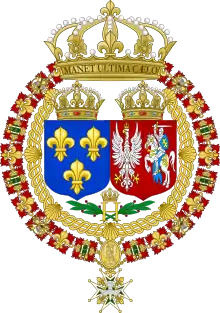
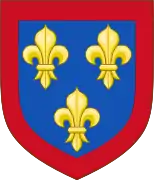
.svg.png.webp)
